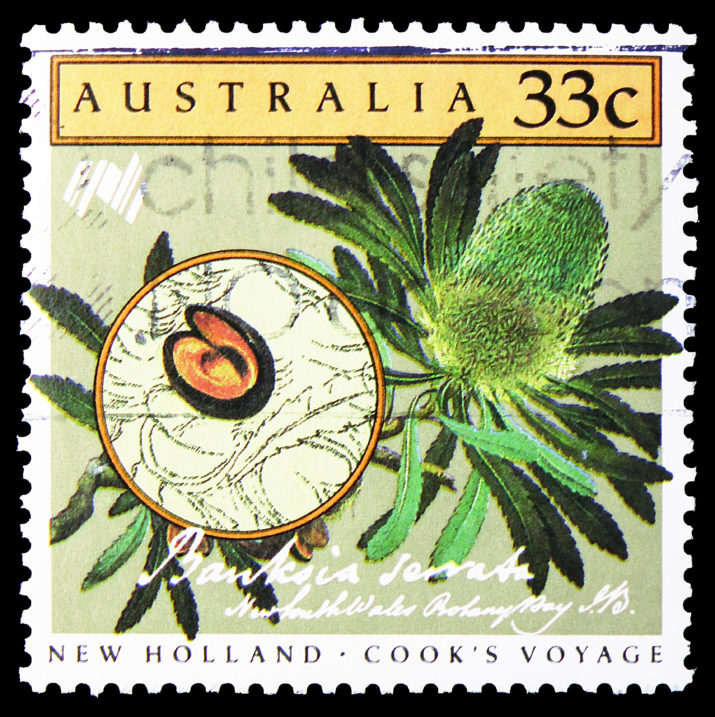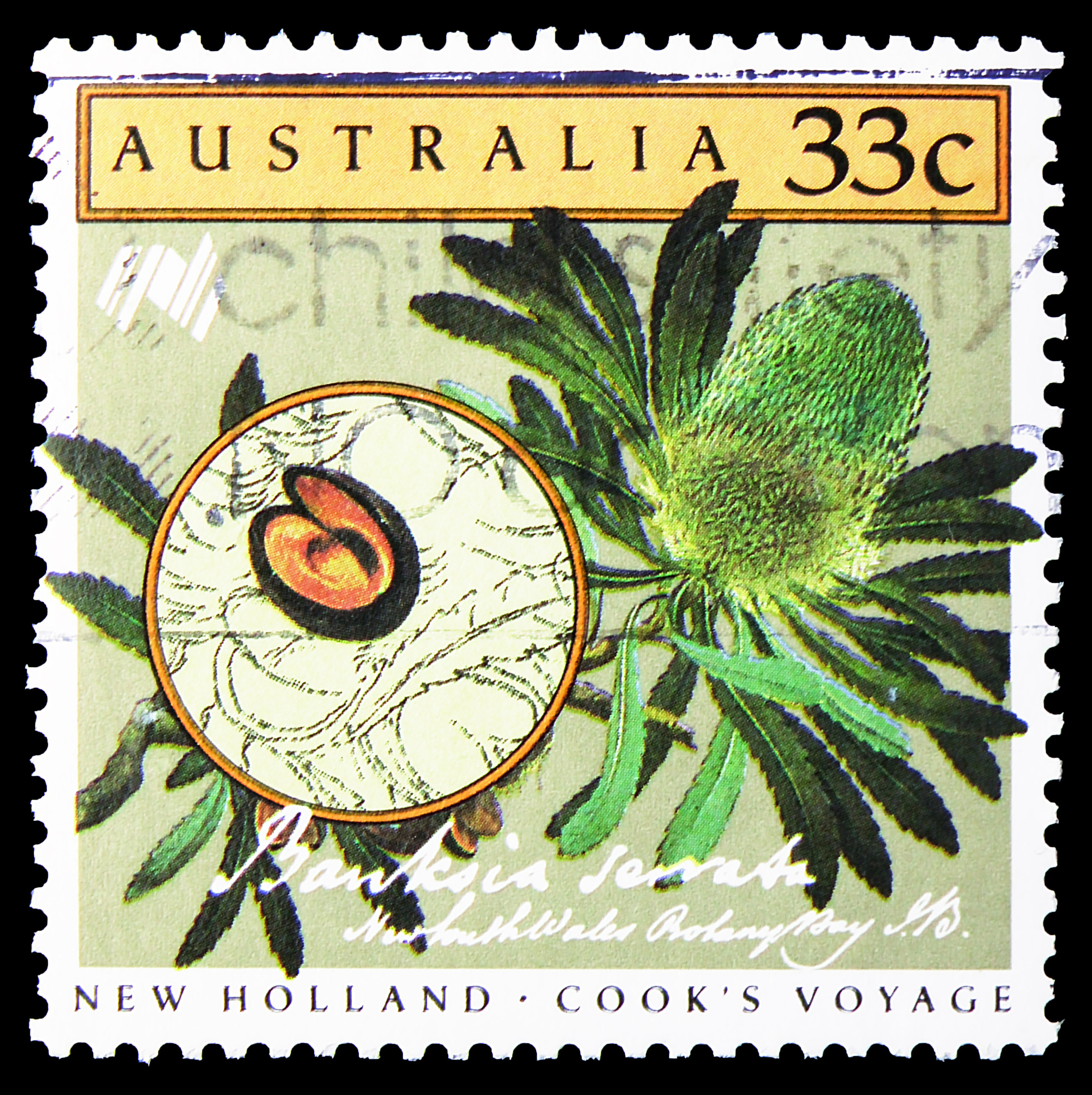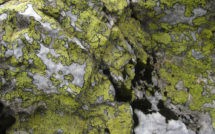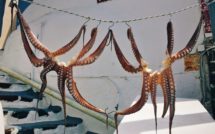

This is part of our special feature, Rethinking the Human in a Multispecies World.
Warning: Readers of this article are warned that it may contain terms, descriptions, and opinions that could be culturally sensitive to Aboriginal and Torres Strait Islanders.
Banksia serrata (B. serrata) is a species of native Australian tree that catches stories of colonial dominion, botanical naming controversies, and Indigenous knowledge in its branches. In the wild, B. serrata is found in sandy soils along the eastern coast of Australia.[1] It can grow to become very tall, twisted, and architectural, with leathery bark like ancient hide. In cultivation, this remarkable tree is popular in private and public gardens, having made its way around the globe as early as 1788 to eventually colonize habitats such as the Temperate House, a Victorian glasshouse at the Royal Botanic Gardens, Kew in London. In this essay, we frame B. serrata within a discussion of non-mastery, whereby efforts to redress human dominion over trees or European dominion over Australian native plants needs to avoid committing new kinds of slow violence.[2]
Plant xenophobia and Aboriginal absences
If B. serrata has managed to survive fires, its blackened trunk offers a strong contrast to glossy evergreen saw cut leaves. In the summer, it is dotted with creamy-green brush cone-shaped inflorescences that are attractive sources of nectar for birds, insects, and peoples.[3] With pollination, the flowers age to grey woody cone-like structures, with large bulging seed follicles, like sleeping eyes in the bush. These follicles startle open to release their seeds in response to fire. Despite its resilient beauty, the perception and experience of B. serrata’s seed cones, for many Australians, is discolored by the memory of childhood books by May Gibbs (1877-1969), who characterized the banksia cones as evil black men who might steal your (white) children away. Revered Australian Indigenous poet Evelyn Araluen’s inquiry into the rejection of Aboriginal bodies in Gibbs’ Snugglepot and Cuddlepie draws attention to Gibbs’ “casting-out of the recurring villains, the Banksia Men, who are aligned with savagery, animism, sexual deviancy, and Aboriginality throughout the stories.”[4]
Conceptions of B. serrata are troubled by these lingering twentieth-century perceptions, which connect to recent discourse concerning the violence of colonialism and anti-colonialism. Gibbs paradoxically maintained in her writing a moral warning to her readers to care for wild bush animals and vegetation such as the banksia, in an effort to redress colonial disdain for native species. Her bush ethos also revealed the gaping absence of Aboriginal people in her stories. Perhaps innocently, Gibbs created a new violence, the violence of absence. This disturbing logic of absence is tragically integral to Australian genocides and stolen generations of Australian Aboriginal people and their children. Where Gibbs can be recognized as an anti-colonial moralist, her elimination of Aboriginal people (except through the racist anthropomorphism of B. serrata seed cones), reflects an evasion of responsibility, which is, according to non-mastery theories,[5] no better than a new violence. This Australian experience mirrors other settler colonies around the world where Indigenous eliminations take many forms—not just absences from stories or archives, but elimination via land redistribution, pollution, renaming, and even termination (loss of previous treaty rights) by settler colonists, which has had lasting impacts not only socially but environmentally.[6] As Maori scholar Linda Tuhiwai Smith says, “Renaming the land was probably as powerful ideologically as changing the land…”[7] In addition, the power of absence and non-naming are as politically powerful as re-naming.[8] If non-naming and re-naming carry political and social weight, then including Aboriginal names in western botanical classification may be a complex but necessary process. Looking again at B. serrata as our example, and approaching an examination of Australian colonial past, it is time to re-assess the power that names have to inform our relationships with plants, the land, each other, and the impacts of colonial mastery. This requires careful and respectful consideration of the Indigenous knowledge absent or present in herbaria archival information without undermining the value of extant taxonomic data for western science.
Biopower and the name-claiming of B. serrata
The western scientific name, Banksia serrata, acknowledges Joseph Banks in the genus name; the species name serrata is derived from the Latin serratus, meaning serrate or saw-edged leaf margin. In the 239 years since it was first given a western scientific binomial name (genus and species) it has accumulated several English common names: old man banksia, saw-tooth banksia, honeysuckle, red honeysuckle, and saw banksia. The Atlas of Living Australia website records only one Indigenous name for this plant: wiriyagan, a name from the Cadigal people of the Sydney region of New South Wales.[9] Given that the natural distribution of B. serrata covers much of the eastern seaboard of Australia passing though the countries and languages of many Australian Aboriginal peoples, it is likely that there are many more rich names for B. serrata, that reflect subtleties in culture, season, and situation.[10]
B. serrata is one of the four banksia species collected by Joseph Banks (1743-1820) and Daniel Solander (1733-1782) from Ka-may [11] (Botany Bay, NSW) in April 1770, as part of the HMS Endeavour voyage.[12] These plants were not given formal western scientific names until they were published in 1782 as part of the genus Banksia by Carl Linnaeus the Younger (1741-1783).[13] His father, Carl Linnaeus (1707-78), developed the system of classifying and naming organisms with binomials, first published in his Systema Naturae in 1735. As B. serrata was the first “named” species in the Banksia genus, it is also the primary reference point (or “type”) for defining the nomenclature of the genus.[14] It is important to acknowledge that Indigenous Elders already knew many of the plants that Europeans “discovered” and subsequently named in Australia, and had known them for millennia.
The naming of plants is a complex problem—who gets to name, what names can be used, what and who are they named for? Naming is critical for ongoing botanical and ecological knowledge production and sharing. It is also vital for conservation, as being certain which plant a scientist is referring to allows for the charting of change and provides pins to which new knowledge can be attached and sorted, crucial at this time of catastrophic climate and biodiversity crisis. The history of the western scientific classification of B. serrata is best viewed by reading down the webpage of the Australian Plant Name Index (APNI).[15] This site lists many of the scientific publications that relate to the classification and re-classification of B. serrata as taxonomists have developed or changed their understanding of how to position species within the constantly shifting constellations of naming and classification systems. This historical inventory at once disputes and illustrates mastery by showing the curation and sifting of names that occurs as each author interrogates the legitimacy of names selected, and debates whether proposed names follow agreed naming conventions. These papers also describe occasions where collected specimens, thought to be a newly described species, are argued to be variations of B. serrata—showing the constant flexing of the boundaries that defined the concept of “species.”[16]
Naming in European cultures also carries legacies of class, power, imperial dominance, and settler exclusivity. Dan Bousfield wrote, “The language of botany, zoology and history is embedded in structures that refer to natives, immigrants, colonists, hybrids and aliens alongside invasion, immigration, competition, conquest, colonisation and pioneering.”[17]Non-mastery theorist Julietta Singh writes of ways to disrupt mastery over land, people and women, and how to avoid falling back into new forms of linguistic and intellectual violence.[18] Singh proposes that anti-colonial writers such as Frantz Fanon and Mohandas Ghandi failed because they replaced colonial violence with protest violence and bodily self-governing violence, respectively. Her solution is using language to strip away colonial and neo-colonial masteries, by unlearning and then re-learning. The botanical practice of claiming and naming of plants, as with B. serrata, has (so far) remained in a gendered and racial frame of mastery over the trees and over those who may not name.[19]
In 2013, Michael Davis wrote:
Indigenous knowledge, historically, has been viewed as being of lesser validity than dominant Western knowledge, especially what is ‘defined’ as science. Colonial practices of exploration, ‘discovery’ and settlement have reinforced this view, rendering indigenous knowledge invisible in Europeans’ eyes, or worse subjugated within dominant knowledge regimes.[20]
Davis speculates on the Indigenous knowledges that may have been collected and incorporated in the information that early botanists gathered—that these different systems contained both “common ground” and “radical incommensurability.”[21] Indigenous knowledge systems seem so far to have been excluded from western scientific conception of B. serrata even though these plants would have been well known to the Indigenous community for millennia. While it is true that Western science often uncritically asserts “discovery” of species, there are signs that the importance of prior Indigenous names and knowledge systems are beginning to be recognized in recent articles published by taxonomists and ecologists.[22] As Davis suggests, this knowledge has always been of importance to Western science but its inclusions and exclusions within knowledge production is not always decipherable—depending on vantage point. Careful work in herbaria continues to highlight the Indigenous knowledge and practice that has been recorded along with plant specimens. Making this knowledge equitably accessible sits at the edge of biocultural conservation and social justice work within collections management.[23]
The importance of Indigenous names in helping to understand plants, country, and the ecological relationships in which the human and non-human are bound, is now being brought to our attention by Indigenous Australian scholars. Professor Jakelin Troy, University of Sydney, a Ngarigu woman, has advocated Australians learn these Indigenous “names and knowledge systems for trees and plants that are lost to everyday use” seeking the deep understandings encoded within them.[24] The Melbourne University based scholar Zena Cumpston, a Barkandji woman, seeks to “reawaken and reinvigorate knowledges” through her work, proposing a potential sharing and shifting of knowledges in “reciprocity” between Western science and Indigenous science. Cumpston argues that this hybrid or reciprocal approach has the potential to generate new and important understandings.[25]
Options of First Nations’ redress in terms of plant naming are risky and complex because adopting Indigenous knowledge into Linnaean systems may not be culturally adequate. Moreover, incorporating Indigenous knowledge presents challenges such as the need to obtain cultural permissions and the threat of dispersing meanings and secret usage across multiple places and people. Tri-naming (Latin name, common name, Indigenous name) is equally complicated by the multiple names for plants across many languages, as well as their seasonal or situational names, and the need to seek permission from Elders across widely distributed areas.[26] The latest non-mastery question is whether tri-naming of plants is feasible. Highly effective work in Australian place-naming, led by such scholars as Jakelin Troy, has now resulted in highway, region, and town signage bearing Indigenous names, along with traditional place names now evident on most television programs and universities ensuring the naming of places, during event introduction Acknowledgements to Country.[27] While this is positive work, the tri-naming of plants or adding of Indigenous names to the Latin and common names is a slow and extremely complex process relying on the formation of authentic and inclusive partnerships between Western science and Indigenous Elders. In staking out the origins of climate change with the advent of colonial slavery, Kathryn Yusuff proposes the use of “grammars of dissent” as a refusal of colonial codes, a refusal that could be applied to codes of taxonomic absence and exclusion.[28] There is here too the danger that, without careful and mindful work, this becomes another form of mastery, appropriation, and colonization of Indigenous knowledge
In response to the debate on tri-naming, digitization expert Claire Brandenburger at the Sydney Royal Botanic Gardens Herbarium said, “Indigenous knowledge is worth so much more than just a third name.”[29] Concerned about protecting this knowledge from exploitation, Jakelin Troy reminds us that Indigenous names for plants also hold valuable knowledge about plant use and ecology.[30] In particular, in the context of species hierarchies and the way plants are fought over in terms of biosecurity eco justice, eco-critical thinker Rosi Braidotti applies Foucault’s biopolitics to plants,[31] Indeed, biopolitics is at play as herbaria and archives carefully protect their data, which could lead to the illegal harvesting and exploitation of Indigenous knowledge or the theft of rare plants. These unlawful and unethical activities inform the bio-power relations of the plant world and raise questions about who makes and enforces legislation to protect plants and what say Indigenous Elders have in the process. Some responses have come in the form of the Convention on Biological Diversity published in 1993, further refined by the Nagoya Protocol, published in 2011 by the Secretariat of the Convention on Biological Diversity, which were the first international conventions developed to mediate the sharing of biological benefits from traditional knowledges.[32]
Reframing banksia
As we look again through the branches of the banksia tree, we see that the story of imagining, naming, and claiming Banksia serrata illustrates the kinds of systemic exclusions that have occurred within the botanical world. The history of western taxonomy is relatively short, just over 280 years old, affording it a parallel position with settler histories, colonial imperialism, and related dominant botanical traditions. While the botanical world would no doubt be unwilling to surrender implicit procedures of collecting and naming, there are hopeful signs that change is occurring and that masteries are shifting as they are challenged on multiple fronts. There is potential for another chapter to this story as Botanic Gardens around the globe engage in the creation of decolonization strategies seeking to un-learn and un-master understandings of the botanical world. Taxonomy has always been a plastic mastery full of change and adaption. Could a re-engagement with First Nations’ knowledges re-invigorate interest in teaching and subsequent enrolments in this vital work? As we seek to un-learn and un-master our conventional human relationships with flora, fauna, landscapes, and each other, there is perhaps an opportunity for reconciliation of the Imperial project. The power of Indigenous names and voices could provide new hybrid views creating critical, and healing understandings.
Prudence Gibson is an author and academic at the School of Art and Design, University of NSW, Sydney. She is Lead Investigator of an Australian Research Council grant in partnership with Sydney’s Royal Botanic Gardens Herbarium. Her recent books are The Plant Contract (Brill Rodopi 2018), Janet Laurence: The Pharmacy of Plants (NewSouth Publishing 2015), and her forthcoming book, The Herbarium and Me will be published in November 2022.
Sharon Willoughby is an environmental historian with a background in ecological science. After 18 years working for the Royal Botanic Gardens Victoria, most of that time as part of the Landscape Planning Group for the Australian Garden at Cranbourne, she is now the Head of Interpretation at the RBG Kew in London. Her recent publications include: The Agius Evolution Garden (Kew Publishing 2020) and contributions to Curating the Future: Museums, communities and climate change (Routledge 2017).
The authors acknowledge the traditional custodians of the land about which they write, and pay respect to Elders past, present, and emerging. Gibson writes from Gadigal land of the Eora nation.
References
[1] Australia, Atlas of Living. “Species: Banksia Serrata.” Search species. Accessed August 12, 2021. https://bie.ala.org.au/species/https://id.biodiversity.org.au/taxon/apni/51293610.
[2] J.M. Bacon, “Settler Colonialism as eco-social structure and the production of colonial ecological violence,” Environmental Sociology 5, 1, (2018): 64
[3] Prepared by Ken Macintyre and Barb Dobson Research anthropologists. “The Consumption of Banksia Nectar in Traditional NOONGAR SOCIETY.” Anthropology from the Shed, October 17, 2019. Accessed August 8, 2021. https://anthropologyfromtheshed.com/project/the-consumption-of-banksia-nectar-in-traditional-noongar-society/.
[4] Evelyn Araluen. “Snugglepot and Cuddlepie in the Ghost Gum,” Sydney Review of Books 11 February (2019), https://sydneyreviewofbooks.com/essay/snugglepot-and-cuddlepie-in-the-ghost-gum-evelyn-araluen/
[5] Singh, Julietta. Unthinking Mastery: Dehumanism and Decolonial Entanglements. (Durham: Duke University Press, 2018).
[6] J.M. Bacon, “Settler Colonialism as eco-social structure and the production of colonial ecological violence” Environmental Sociology, 5, 1, (2018): 63.
[7] J.M. Bacon, “Settler Colonialism as eco-social structure and the production of colonial ecological violence” Environmental Sociology, 5, 1, (2018): 63.
[8] Linda Tuhiwai Smith, Decolonising Methodologies: Research and Indigenous People (London: Zed, 2012).
[9] Australia, Atlas of Living. “Species: Banksia Serrata.” Search species. Accessed August 12, 2021. https://bie.ala.org.au/species/https://id.biodiversity.org.au/taxon/apni/51293610.
[10]“Map of Indigenous Australia” AIATSIS. Accessed 28 August 2021. https://aiatsis.gov.au/explore/map-indigenous-australia.
[11] “Place Names Chart.” The Australian Museum. Accessed August 12, 2021. https://australian.museum/learn/cultures/atsi-collection/sydney/place-names-chart/.
[12]Australia, Atlas of Living. “Species: Banksia Serrata.” Search species. Accessed August 12, 2021. https://bie.ala.org.au/species/https://id.biodiversity.org.au/taxon/apni/51293610.
Kevin Collins, Kathy Collins and Alex George, Banksia (Melbourne, Australia: Blooming Books Pty Ltd, 2020). Pages 1- 3.
[13] Linnaeus the Younger, Carolus. “Supplementum Plantarum.” Botanicus.org: Supplementum plantarum SYSTEMATIS VEGETABILIUM Editionis decimae Tertiae, generum plantarum Editionis sextae, et SPECIERUM plantarum EDITIONIS SECUNDA. Accessed July 30, 2021. http://botanicus.org/page/411159.
[14] Kevin Collins, Kathy Collins and Alex George, Banksia (Melbourne, Australia: Blooming Books Pty Ltd, 2020). Page 3.
[15] “Vascular Plants.” Vascular Plants APNI – Banksia+serrata+L.f.? Accessed August 8, 2021. https://biodiversity.org.au/nsl/services/search/names?product=APNI&tree.id=&name=Banksia%2Bserrata%2BL.f.&inc._scientific=&inc.scientific=on&inc._cultivar=&inc._other=&max=100&display=apni&search=true.
[16] Donoghue, Michael J. “A Critique of the Biological Species Concept and Recommendations for a Phylogenetic Alternative.” Accessed August 12, 2021. https://www.jstor.org/stable/3243026.
“Species Concept.” Species Concept – an overview | ScienceDirect Topics. Accessed August 12, 2021. https://www.sciencedirect.com/topics/earth-and-planetary-sciences/species-concept.
[17] Dan Bousfield, “Settler colonialism in vegetal worlds” Settler Colonial Studies 10, 1, (2020): 20.
[18] Julietta Singh, Unthinking Mastery: Dehumanism and Decolonial Entanglements (Durham: Duke University Press, 2018).
[19] Lindon, H.L., L.M. Gardiner, A Brady, and M.S. Vorontsova. “Fewer than Three Percent of Land Plant Species Named by Women: Author Gender over 260 Years.” Taxon 64, no. 1 (2015). https://doi.org/DOI: 10.12705/642.4.
[20] Davis, Michael. “Davis Encountering ABORIGINAL KNOWLEDGE.” Academia.edu. Accessed August 8, 2021. https://www.academia.edu/17327010/Davis_Encountering_Aboriginal_Knowledge. Page 31.
[21] Davis, Michael. “Davis Encountering ABORIGINAL KNOWLEDGE.” Academia.edu. Accessed August 8, 2021. https://www.academia.edu/17327010/Davis_Encountering_Aboriginal_Knowledge. Page 33.
[22] Priscilla M. Wehi, Gretchen Brownstein and Mary Morgan-Richards, “Indigenous plant naming and experimentation reveal a plant-insect relationship in New Zealand forests”, Conservation Science and Practice, 2020;2: e282. http://doi.org/10.1111/csp2.282
Christopher H. Trisos, Jess Auerbach and Madhusudan Katti,” Decoloniality and anti-oppressive practices for a more ethical ecology” Nature Ecology & Evolution (2021).https://doi.org/10.1038/s41559-021-01460-w
Sandra Knapp, Maria S. Vorontsova and Nicholas J. Turland, “Indigenous Species Names in Algae, Fungi and Plants: A Comment on Gillman & Wright” Taxon 31 December 2020,
https://doi.org/10.1002/tax.12411.
[23] Sara Maroske, “‘A taste for botanic science’: Ferdinand Mueller’s female collectors and the history of Australian botany,” Muelleria 32:72-91 (2014).
[24] “Trees are at the heart of our country – we should learn their Indigenous names”. The Guardian. Accessed 28 August 2021. https://www.theguardian.com/commentisfree/2019/apr/01/trees-are-at-the-heart-of-our-country-we-should-learn-their-indigenous-names
[25] Zena Cumpston,” Illuminating Indigenous Culture Through Plants”. Accessed 22 August 2021. https://pursuit.unimelb.edu.au/articles/illuminating-indigenous-culture-through-plants
[26] Fire and seasons vegetation calendar, Wattleridge, Australia https://www.firesticks.org.au/winba-fire-the-wattleridge-ipa-fire-and-seasons-calendar/
[27] See University of NSW Indigenous strategy 2018-25 https://www.indigenous.unsw.edu.au/sites/default/files/documents/UNSW%20Indigenous%20Strategy%202021_web.pdf
[28] Kathryn Yusuff, A Billion Black Anthropocenes or None. (Minneapolis: University of Minnesota Press, 2018.)
[29] Author interview with Claire Brandenburger, zoom, 10th August 2021
[30] The Plant hunter “Say My Name: On Speaking the Indigenous Names of Plants”. Accessed 29 August 2021. https://theplanthunter.com.au/culture/say-name-speaking-indigenous-names-plants/.
[31] Rosi Braidotti, “Posthuman, all too human, towards a new process ontology,” Theory, Culture Society, 23, 7-8 (2006) :198
[32] Buck, Matthias, and Clare Hamilton. “The Nagoya Protocol on Access to Genetic Resources and the Fair and Equitable Sharing of Benefits Arising from Their Utilization to the Convention on Biological Diversity.” Review of European Community & International Environmental Law 20, no. 1 (2011): 47–61. https://doi.org/10.1111/j.1467-9388.2011.00703.x.
Photo: MOSCOW, RUSSIA – JUNE 19, 2019: Postage stamp printed in Australia shows Banksia serrata, 200 years of Colonization of Australia serie, circa 1986 | Shutterstock
Published on November 9, 2021




